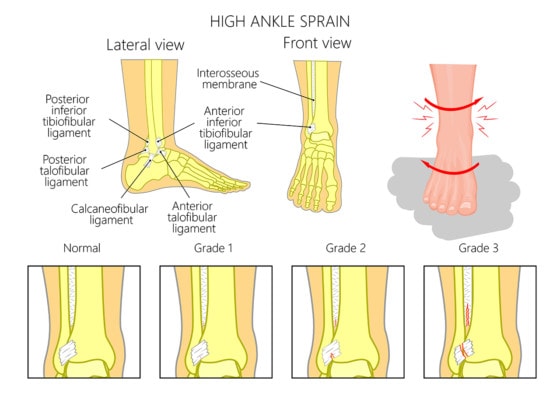Want to Shorten High Ankle Sprain Recovery Time? Get Your Platelets Injected for a Faster Recovery
High ankle sprain recovery time can be long because the ankle is often unstable. PRP or platelet rich plasma has been a hot topic in orthopedic care this past few years. While PRP has been shown to help tendonitis better than traditional steroid treatments, one big question was whether it could be used to get athletes back to sports more quickly. Now a new study suggests that it can do just that when used with high ankle spains.
Platelet rich plasma is created when whole blood is collected and centrifuged to isolate the platelet fraction. The platelets are the small cell like parts of the blood that help it clot and also release growth factors to help the wound heal. By concentrating these platelets, it’s thought that non-healing wounds can be prompted to heal. However, can those same platelets also allow an acute injury to heal faster and help an athlete return to sports faster after an injury?

Aksanaku/Shutterstock
High ankle sprains are when the outside ligaments of the ankle are stretched along with the additional ligaments that hold the fibula bone to the tibia bone. They are unstable, so the joint moves around too much, making recovery difficult. As a result, they take a long time to fully heal. In addition, some patients end up with surgery or residual pain. The new study looked at athletes with a “high ankle sprain”. The patients had a careful exam which included looking under ultrasound to make sure the ligaments were lax, indicating an unstable ankle joint. The research compared a group who received PRP injections into these ligaments versus a control group who did not. The study was unique in that these patients were diagnosed early and in that situation, those treated with PRP had a shorter return to play time of 40.8 days (±8.9) compared to the group not treated who took 59.6 (±12.0) days to retrun (p = 0.006). Significantly less residual pain upon return to activity was found in the PRP group; five patients (62.5 %) in the untreated group returned to play with minor discomfort versus one patient in the PRP (12.5 %). One patient in the untreated group had continuous pain and disability and subsequently underwent ankle reconstructive surgery.
The upshot? In this study, early diagnosis and treatment of a bad ankle ligament injury was found to respond well to PRP injections. In fact, those athletes who got the injections returned to play faster and had less residual problems. This is consistent with what we see in our clinic when treating ankle injuries. Now if the rest of the physicians injecting unhelpful steroids and operating on these poor patients would just get the memo!
If you have questions or comments about this blog post, please email us at [email protected]
NOTE: This blog post provides general information to help the reader better understand regenerative medicine, musculoskeletal health, and related subjects. All content provided in this blog, website, or any linked materials, including text, graphics, images, patient profiles, outcomes, and information, are not intended and should not be considered or used as a substitute for medical advice, diagnosis, or treatment. Please always consult with a professional and certified healthcare provider to discuss if a treatment is right for you.